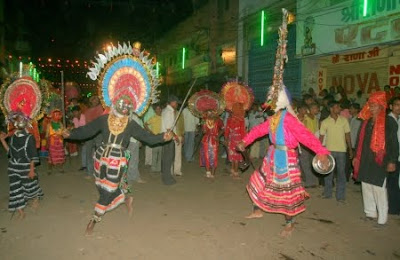

 en February And April.
en February And April. Yatra to Kashi - A Journey which draws people to the River Ganges, with an ingrated belief that these waters can absolve the sins of many generations. This Blog of mine is an attempt to Unfloding and Celebrating the Ritual Contact with the Holy Ganges. This Blog is also a guide to performing the Hindu Rites in the Right way.Let us go on a pilgrimage to the holy city within Banaras called "Kashi" - The City of Light...


 en February And April.
en February And April. 





Location: City Center
Property Type: Business And Leisure Hotel
Hotel Varanasi Ashok is located in the ancient and venerable city for Hindus, it is a modern 5-storeyed structure. The property is situated on the Mall Road in the cantonment area of Varanasi. It is an ideal location to explore the wonders of this unique city, and experience the pulse of a glorious civilisation.
Accessibility: Airport (Domestic): 22KM., City Center: 4KM., Railway Station: 1.5KM., Shopping Center: 4KM.
*******************************
For more details on Hotels and on-line bookings, you may click the link below:
http://www.hotelscombined.com/City/Varanasi.htm

Hotel India is placed in the most peaceful of greener environments of the city of Varanasi. With easy accessibility & strategically located, it serves its customers with personal touch of hospitality. Hotel India promises you a luxurious and peaceful stay promising you a time that would made make you want to come back & enjoy its hospitality again.
Accommodation : 80, luxurious air-conditioned rooms including 15 executive rooms & 3 Porsche suits await the guests at the Hotel. Room facility includes colour Televisions (with satellite channels) & a Refrigerator in each room. The attached bathrooms are compact with hot & cold running water.
Hotel India surpasses your dreams of perfect Hotel and promises for a pleasant stay in Varanasi.

Hotel Ganges View is situated on the bank of river Ganga at Asi Ghat which is among one of the five major sacred places, Pancha Tirtha, of Kashi or Varanasi. It’s the place where river Asi joins Ganga on her northward flow. The place marks the southern boundary of the holy city and remained the abode of saints and seers, poets and pundits.
Saint poet Tulsidasa wrote a part of his celebrated epic, Ramacharitamanas, at this place nearly four hundred years ago.


Location:
City Center
Property Type: Heritage Hotel
The scenic beauty of Holy Ganges river enchanted the erstwhile rulers of "Hathwa Raj" to construct this palace during middle of 19th century. With the passage of time and for suitable utilisation, the palace was converted into a heritage class hotel depicting the ancient Indian culture with its paintings, carvings and antiques.
Accessibility: Airport (Dom): 22KM., Bus Stand: 1KM., Ghats: 1KM., Railway Station: 1.5KM., Sarnath: 10KM., Shopping Center: 0.5KM.

Diamond Hotel is the city’s most centrally located downtown hotel. Walking distance from the Ghats of Varanasi and the revered temples of the holy city, the hotel is also in close proximity to the Banarsi Saree market and the Banaras Hindu University. Its location makes it ideally located for all – businessmen, tourists, and pilgrims.
Location: 5 kms from Ramnagar fort 12 kms from Sarnath2 Kms. from Banaras Hindu University22 Kms. from Varanasi Airport5 Kms. from Varanasi Cantt. Railway Station & Bus Terminal16 Kms. from Mughalsarai Railway Station
Services :
24 hour room service, laundry, lockers, bank, foreign exchange counter, car rental, car park, doctor on call, credit card facility.
Location: City Center
Property Type: Business And Leisure Hotel
Hotel Clarks Tower is located 21 Kms away from airport, 3 kms from railway station and 7 kms from downtown, old city & riverfront & 7 kms from Sarnath. It is newly-constructed modern hotel, ideally located in the calm and serene surrounding. It has tastefully decorated rooms housed in a modern building.
Accessibility: Airport: 21KM., Railway Station: 3KM., Sarnath: 7KM.

Location : 20 kms from Airport, 1.5 kms from Railway Station, 6 kms from Downtown Area.
ROOMS : 50,Rooms All with Bath Attached and all Double.
CORPORATE & OTHER FACILITIES

Enticing guests with its' location, this leisure hotel, with beautifully decorated rooms and excellent service is close to both the commercial area and attraction spots. The Hindustan International Hotel in Varanasi welcomes guests in its' elegant sky-lit atrium and offers stylish, well maintained rooms with comfortable beds as well as modern facilities.
LOCATION: 20 kms from Airport, 1 km from railway station & 2 kms from downtown area.
ACCOMODATION : 108 rooms.The magic of Benares is best experienced with a slow boat ride down the river at dawn.
Leisure:
Other Facilities & Services:

Location:
21kms from Airport3 kms from Railway Station7 kms from Downtown, Old City, and Riverfront7 kms from Sarnath (where Lord Buddha preached his first sermon)
Hotel Clarks Varanasi is an island of tranquility in the ancient city of Varanasi. Making the stay here truly unforgettable, are a whole range of modern amenities. The splendid structure of this hotel dates back to over half a century. Which is why the spacious rooms have a colonial accent, with wide verandahs opening on to lush gardens. Complementing this luxury are the choicest of restaurants, an outdoor swimming pool in a secluded garden, splendid conference halls, and a business centre equipped for efficient service.
Guest Rooms: 113 tastefully furnished rooms, including 10 Executive rooms, 9 Deluxe rooms and 2 Suites. These spacious rooms are aesthetically designed and tastefully furnished. All rooms have individually controlled airconditioning, attached bathrooms, satellite television, free in-house movies and international direct-dialing facility.
Dining & Entertainment:




 Nag Nathaiya of Varanasi
Nag Nathaiya of Varanasi









 rwat Kashi:
rwat Kashi:







